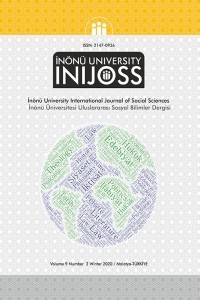Nietzsche'nin "Tanrı Öldü" Sözüne Arka Pencereden Bakmak: Sevgi Dolu Bir Tanrı Arayışı
Looking to Nietzsche's Word "God is Dead" from Back Window: A Quest for a Loving God
___
- 1. Cybulska, Eva. (2016). Nietzsche Contra God: A Battle Within. Indo-Pacific Journal of Phenomenology: Volume 16, Editions 1 & 2 October 2016 Page 1 of 12. ISSN (online) : 1445-7377 ISSN (print) : 2079-7222.
- 2. Deleuze, G. (2021). Nietzsche ve Felsefe. (Çev. Ferhat Taylan). İstanbul: Norgunk Yayıncılık.
- 3. Haar, Michel. (1997). Nietzsche and The Metamorphosis of The Divine. Book Post-Secular Philosophy Edition 1st Edition, First Published 1997, Imprint Routledge. Pages 11 eBook ISBN9780203423516.
- 4. Heidegger. (2001). Nietzsche'nin tanrı öldü sözü ve dünya resimleri çağı. Çev. Levent Özşar. Bursa: Asa Kitabevi.
- 5. Horyna, Bretislav. (2020). The History of The Dead God - The Genesis of 'The Death of God' in Philosophy and Literature Before Nietzsche. Constantine the Philosopher University, Nitra, Slovakia, Research Paper. Pro-Fil 21 (2) 2020: 1–17. https://doi.org/10.5817/pf20-2- 2178.
- 6. Kijowski, James L. (1999). A Critique of Ricoeur's Call For Faith From The Atheism of Nietzsche: God is Still Dead. Denison University. Episteme - Volume X - September - 1999.
- 7. Nietzsche. (1993). Dionysos Dithyrambosları. Çev. Oruç Aruoba. İstanbul: Kabalcı Yayınları.
- 8. Nietzsche. (1995). Gezgin ile Gölgesi. Çev. İsmet Zeki Eyüboğlu. İstanbul: Broy Yayınları.
- 9. Nietzsche. (1997). Böyle Buyurdu Zerdüşt. Çev. Turan Oflazoğlu. İstanbul: Milli Eğitim Basımevi.
- 10. Nietzsche. (1998). Ecce homo kişi nasıl kendisi olur. Çev. Can Alkor. İstanbul: Yapı Kredi Yayınları.
- 11. Nietzsche. (2001a). Tan kızıllığı. Ankara: İmge Kitabevi Yayıncılık.
- 12. Nietzsche. (2001b). Deccal. Çev. Oruç Aruoba. İstanbul: Hil Yayıncılık.
- 13. Nietzsche. (2001c). İyinin ve Kötünün Ötesinde. Çev. Ahmet İnam. İstanbul: Yorum Yayınevi.
- 14. Nietzsche. (2002a). Güç istenci. Çev. Sedat Umran. İstanbul: Birey Yayıncılık.
- 15. Nietzsche. (2002b). Putların Alacakaranlığı. İstanbul: Say Yayınları.
- 16. Nietzsche. (2003a). Şen Bilim. Çev. L. Özşar. Bursa: Asa Kitabevi.
- 17. Nietzsche. (2003b). Aforizmalar. Çev. Ali Akdeniz. İstanbul: Babil Yayınları.
- 18. Nietzsche. (2010). Ahlakın Soykütüğü. İstanbul: Say Yayıncılık.
- 19. Pippin, Robert B. (1999). Nietzsche and the Melancholy of Modernity. Source: Social Research , Summer 1999, Vol. 66, No. 2, Hope and Despair (Summer 1999), pp. 495-520. Published by: The Johns Hopkins University Press. Stable URL: https://www.jstor.org/stable/40971334.
- 20. Türkan, Mehmet. (2021). Nietzsche'de Dekadans Kavramının Soykütüğü. Beytulhikme Int J Phil 11 (4) 2021 Doi: 10.18491/beytulhikme. 1857 Research Article: 1537-1565.
- 21. Voelker, David J. (2014). Friedrich Nietzsche: Another Crucifixion. 2014-03-18, 4:08 PM. http://history.hanover.edu/hhr/hhr93_3.html Page 1 of 4.
- ISSN: 2147-0936
- Yayın Aralığı: Yılda 2 Sayı
- Başlangıç: 2012
- Yayıncı: İNÖNÜ ÜNİVERSİTESİ
MATEMATİK DERSİ İÇİN BECERİ TEMELLİ SORU YAZMAYA YÖNELİK BİR KONTROL LİSTESİ GELİŞTİRME ÇALIŞMASI
Ferda YILMAZ, Süleyman Nihat ŞAD
SİVAS YÖRESİ KIRIK HAVALARINDA MAKAMSAL VE RİTMİK YAPI
Ferdi KARAÖNÇEL, Ersan ÇİFTCİ, Ayşe KARAÖNÇEL
RUS KOLONİZASYONUNA KARŞI KENESARI KASIMOV’UN BAĞIMSIZLIK MÜCADELESİ (1837-1847)
KAMU POLİTİKALARI VE YASA(LAŞTIR)MA: TÜRKİYE’DE HÜKÜMET SİSTEMLERİ ÜZERİNDEN KAVRAMSAL BİR ÇERÇEVE
Veysel ERAT, Yahya DEMİRKANOĞLU
Odaksıllık Parametresi Çerçevesinde Güneybatı Anadolu Ağızlarında Şimdiki Zaman İşaretleyicileri
JOHN LOCKE’NİN SİYASET FELSEFESİNDE MÜLKİYET VE DEVLET
Önder TİLCİ, Abdül Samet ÇELİKÇİ
FARKLI DİSİPLİNLERDE SÖZCÜK ÖBEKLERİ: SOSYAL BİLİMLERDEKİ ARAŞTIRMA MAKALELERİ ÖRNEĞİ
SOSYAL MEKANLARDA MEDYA KULLANIMI VE KAMUSAL GÜNDEM
ART NOUVEAU SANAT AKIMI ETKİSİNDE MİMARİNİN KUMAŞ/GİYSİ TASARIMINA YANSIMALARI; ANTONI GAUDI ÖRNEĞİ
